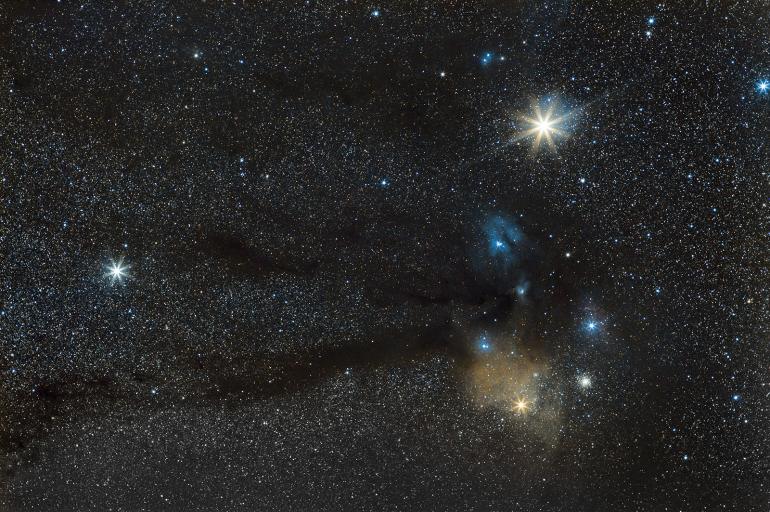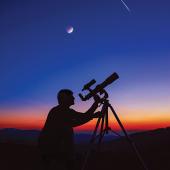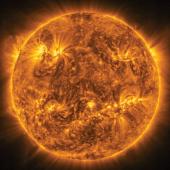Field of Dreams
This season's celestial roll call.
When we hear about spring lineups, we might think of baseball—crisply uniformed rosters, hot dogs and beer, organ music wafting over the ballpark. But you also get lineups in the sky, and this spring has a grand slam’s worth of events to put on your schedule.
Set your alarm for 5:30am on April 5 to see a close “conjunction” of Saturn and Mars low in the east-southeast before sunrise. The planets will be lining up in the sky so that they appear very close together from our vantage point—less than half a degree apart. Of course, they’re nowhere near each other in space; Mars lies about 165 million miles from Earth while Saturn sits about 800 million miles farther out. But their nearly identical brightness makes a lovely amber (Saturn) and orange (Mars) pairing. And just a little to the left blazes the much brighter white Venus, a mere 75 million miles away, making a colorful triple-play of planets before the sun comes up.
The early mornings of April 27-30 offer a second lineup involving Venus, mixing it up with Jupiter this time as the two planets converge over several mornings before sunrise just above the eastern horizon. Start looking around 5:30am. The sliver crescent moon hangs just below the pair on the 27th, and on the 30th, the planets will slide to within half a degree of each other in the sky—Venus the foreground planet about 90 million miles distant (and six times brighter), Jupiter about 525 million miles away—a lovely line-drive of the two brightest planets.
The fourth play of the spring will be a total lunar eclipse on the night of May 15-16.
Wait a couple days and look low in the west after sunset, around 9pm on the evening of May 2, and the moon will have popped out on the other side of the sun, showing another sliver crescent (about 245,000 miles distant) lying roughly between two ruddy “stars.” The one to the right is actually the planet Mercury, 125 million miles away, lying just left of the Pleiades star cluster, some 440 light years beyond. The orange twinkler to the moon’s left is the bright star Aldebaran, some 65 light years away.
Adding to the early-May display may be a dim comet called C/2021 O3 (PanSTARRS), which is scheduled to pass nearest the sun around April 20 and look best in the sky May 3-7, about 50 million miles from Earth. The comet will lie to the right of Mercury and the Pleiades, moving northward on these evenings. There’s a remote chance it will become barely visible to the naked eye, but it’s likely you’ll need a pair of binoculars to see the fuzzy wisp, which could make for a nice pop-fly in the usual tableau of the evening sky.
The fourth play of the spring will be a total lunar eclipse on the night of May 15-16, when the sun, Earth, and moon line up in space so that the moon passes through the southern part of the Earth’s cast shadow. We’ve had a couple such events in the past year, and finally we get one in prime time.
The moon will rise around 8:40pm local time already heading into the umbra, the dark inner part of the Earth’s shadow. It will slip completely in by 9:30, looking ruddy and hanging a little above the southeastern horizon. The total phase will last just under an hour and a half, the moon looking a little brighter at its bottom where it’s closer to the umbra’s edge. It will begin to emerge a few minutes before 11pm, clearing the umbra just before midnight. If the sky cooperates, it should be a glorious—if lurid—sight.
Hindu myth attributed such events to the demon Rahu, who tried to sip the gods’ nectar of immortality. Rahu got tattled on by the sun and moon, and Vishnu—the preserver and protector of the Universe—chopped off his head before he could swallow. His body fell away, but his now-immortal head remains in the sky, vengefully chasing the sun and moon. When he catches up, he tries to swallow them, causing an eclipse, but they fall out of his neck and scamper away—a foul ball every time.
Enjoy the lineups in the sky this spring, and whatever nectar you choose to sip while doing so.
Jim Manning is the former executive director of the Astronomical Society of the Pacific. He lives in Bozeman.











